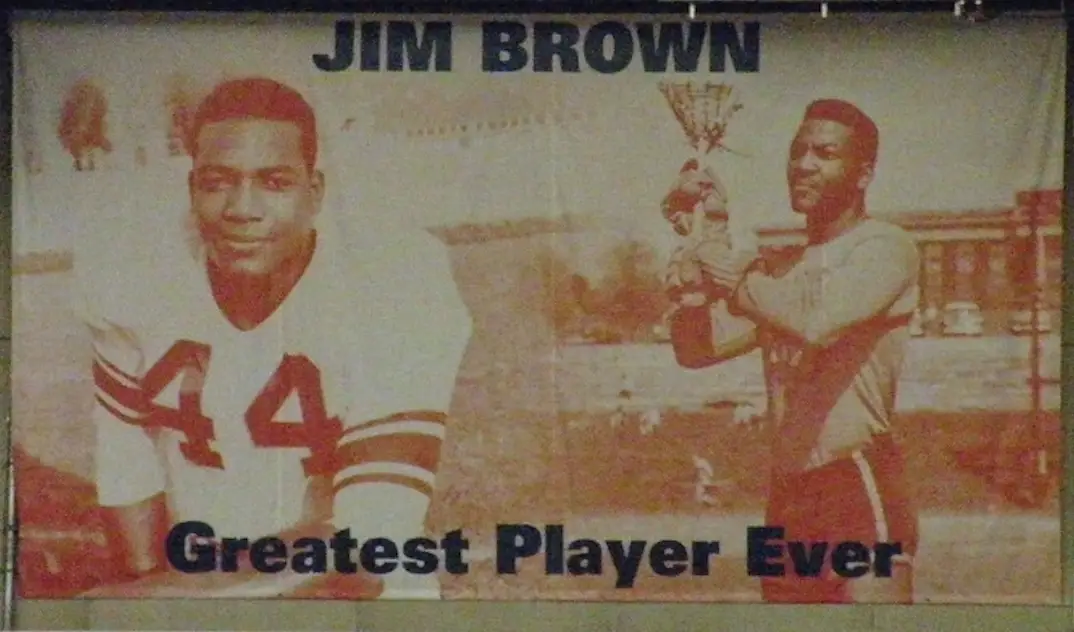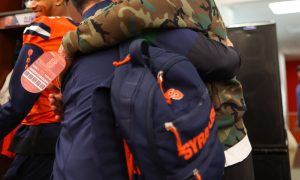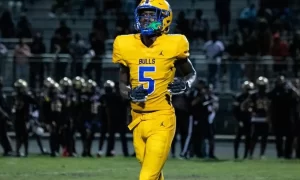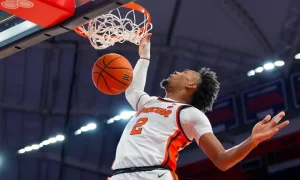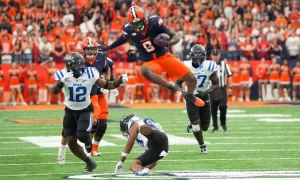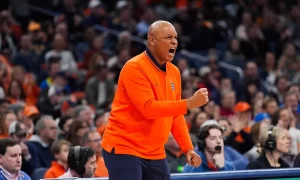Earlier this week, reports started to surface that Syracuse football wideout Trishton Jackson also wanted to walk onto the basketball team in addition to playing for Dino Babers. He’s sitting out this football season due to NCAA transfer rules after coming over from Michigan State, but it appears that he’d be eligible to play for Jim Boeheim because he never played basketball at Michigan State.
And it’s not like Jackson would just be coming from nowhere. He’s been playing in the King of Kings pro-am league in Utica over the summer on the same team as both Buddy and Jimmy Boeheim. Jackson said Coach Boeheim has seen him play and there seems to be a mutual interest for Jackson to walk on after the head man was impressed with what he saw from Jackson at some King of Kings shootarounds and games.
But for now, whether or not Jackson, and possibly Taj Harris and Trill Williams, two other SU football players that also want to play basketball, will actually be on the SU hoops roster come this winter is still very much up for debate. But it did get me to thinking, about some of the other multi-sport athletes in SU history, and there are some pretty big names on that list.
Laura Hurff
The most recent athlete to play multiple sports at Syracuse, Laura Hurff was a three-time All-American on the SU field hockey team from 2014-2017 before playing lacrosse for head coach Gary Gait during spring of her senior year. During her time with the field hockey program, Hurff was a three-time All-ACC selection as a midfielder and forward. The Delaware native is currently on the US Women’s National Team roster.
She only played three games for the lacrosse team in the spring, but that’s after not playing the sport since before high school. Hurff’s lacrosse career may have been short-lived, but her field hockey career will help her go down in Syracuse history as a great multi-sport athlete.
John Mackey
Perhaps the greatest, and certainly most revolutionary, tight end in NFL history, John Mackey is now a Pro Football Hall of Famer after a stellar career with the Baltimore Colts, and it all started in Central New York. Mackey spent three years with SU from 1960-1962 as a running back and wide receiver. His 1961 season as a wide receiver was his most impressive, catching 15 passes for 321 yards from scrimmage, an average of 21.4 yards per reception. He then went on to be the 19th overall pick in the 1963 NFL Draft.
Mackey’s football accolades stand out so much that the prize for college football’s top tight end is named after him, but a lot less is remembered about his time as a member of the SU basketball team. He only played one season on the hardwood when he and Ernie Davis (we’ll get to him next) tried to help out an abysmal SU hoops team that was 2-12 before they got to it. He averaged 4.7 points and 4.7 rebounds per game in six appearances for the Orange.
Ernie Davis
One of the three most famous members of the acclaimed 44-club for SU football, Ernie Davis will forever be remembered as the first African-American player to win the Heisman Trophy back in 1961. He paired that Heisman with two All-American nods in 1960 and 1961 and a national championship in 1959 to go down as not only one of the greatest football players in Syracuse’s history, but as one of the greatest athletes to ever play the game. He would of course go on to be the first overall pick in the 1962 NFL Draft before being diagnosed with leukemia that summer and dying before he could ever play a down in the pros with both his career and life being cut far too short.
However, not many people know he also played basketball in his time at SU. Davis was the star of SU’s freshman team in the 1958-59 season before first-year players could participate on the varsity level. After winning a national title in the face of great discrimination in 1959, he took his sophomore season off from the hardwood before joining John Mackey in trying to help the struggling basketball team in 1961. The Elmira Express played in nine games that year and dropped a very nice stat line of 10.2 points and 9.6 rebounds per game. He will forever be remembered as one of the most influential African-American athletes in college athletics history and you can’t forget about his basketball prowess as a part of that legendary career.
Donovan McNabb
This entry is one that has gained a lot more attention over the last couple of years, but it’s still a bit weird to think about one of the best quarterbacks in SU history playing for Jim Boeheim. As a football player, McNabb was one of the most successful players in the history of the program. He was named Big East Rookie of the Year in 1995 before being named Big East Offensive Player of the Year for three straight seasons from 1996-1998 and a Heisman finalist as a senior in 1998. He of course then went on to be the second overall pick in the 1999 NFL draft.
McNabb’s basketball career spanned his freshman and sophomore years from the winter of 1995 to the spring of 1997. He was a walk-on on the team that lost to Kentucky in the 1996 National Championship game. The next season, he played in 13 games and averaged 2.8 points and 1.3 rebounds and had a very memorable performance versus archrival Georgetown in the Carrier Dome when he scored 10 points on 4-5 shooting against the Hoyas in a tight win. McNabb will forever be remembered as a quarterback, but that performance against Georgetown will always be the stuff of that rivalry’s lore.
Wilmeth Sidat-Singh
Wilmeth Sidat-Singh is one of the lesser-known SU athletic greats, but his impact on the world of not only Syracuse athletics, but college sports in general, is incredibly far-reaching. Born William Webb, both of Sidat-Singh’s parents were African-American. When his dad died as a child, however, his mom remarried a medical student from India named Samuel Sidat-Singh and William soon become Wilmeth and took his new step father’s last name.  Sidat-Singh went on to be a fantastic athlete in Harlem and eventually went on to play both basketball and football at Syracuse, playing a position that was an early predecessor to the modern day quarterback position for the football team and as a guard for the basketball team. But his career was not without controversy.
In a time when most college football teams banned African-Americans from their rosters over even from playing against their teams, Syracuse was one of the first to include African-American players on their teams.  Because of Sidat-Singh’s lighter complexion and his last name, many teams that SU played against were unaware that he was African-American and instead identified him as “Hindu”, which meant that, in their eyes, it was okay for him to play. However, when a black Maryland sportswriter discovered Sidat-Singh’s true racial identity, the University of Maryland refused to allow him to play in a game agains their football team which, in part, ended up costing SU a 13-0 loss. The next year he was allowed to play against the Terrapins and helped lead SU to a dominant 53-0 win in a rematch.  On the whole, the football team went 17-13-2 with Sidat-Singh at the helm, while the basketball team went a combined 40-13 with him on the roster. More than 60 years after his death in a military training accident in 1963, SU retired his basketball jersey to the rafters of the Carrier Dome in 2005, where it stil hangs to this day.
Jim Brown
You all knew this one was coming. I mean there’s a banner of Jim Brown wearing both a football and lacrosse uniform with the words “Greatest Player Ever” underneath him hanging in the Carrier Dome for Pete’s sake. Brown is considered to be not only the greatest running back in NFL history, but also one of the greatest athletes to ever live.
Brown played four sports in his time on the hill. He is best known as a football player for SU, a sport in which he was a consensus All-American as a senior in 1956 and was later drafted by Cleveland Browns as the 6th overall pick in the 1957 NFL Draft. He’d go on to be the NFL Rookie of the Year, nine-time Pro Bowler, three-time MVP, eight-time rushing leader and an NFL champion in 1964, before being enshrined in the Pro Football Hall of Fame.
Outside of football, Brown’s next best sport was probably lacrosse. As the star player in the early days of the now-famed Syracuse lacrosse program. Brown himself even says that lacrosse may have been his best sport and that he loved it even more than football. Many consider him to be the greatest to ever play the game of lacrosse and for good reason. As a junior in 1956 he was second-team All-American before being a first-team selection as a senior when he scored 43 goals in 10 games and was the nation’s second-leading scorer. He even scored a hat trick against Army on the same day as he competed in a track meet for SU. After his incredible, albeit short, lacrosse career, Brown was inducted into the National Lacrosse Hall of Fame in 1983.
As a basketball player, Brown spent two seasons on the hardwood for the SU basketball team, averaging 15 points per game as a sophomore in the 1954-55 season and 11.3 points per game as a junior on a team that went 14-8. He also ran track and finished fifth in the country in the decathlon in 1955. There really was nothing Brown couldn’t do and he is by far the greatest multi-sport athlete in Syracuse history.


